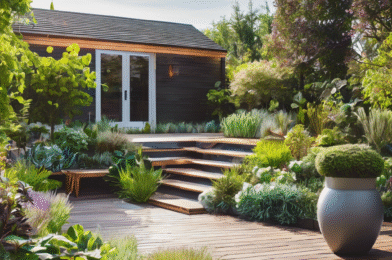### A Step-by-Step Guide to Setting Up Your First Smart Garden
Are you ready to elevate your gardening game? Smart gardens are an innovative and sustainable way to bring technology and nature together. From automated watering systems to soil sensors, the possibilities are exciting. Here’s a comprehensive guide to help you create your own smart garden masterpiece.
1. Planning Stage: Begin by assessing your garden area and deciding on the type of smart setup you envision. Consider the size, location, and available sunlight. Choose a theme, whether it’s an automatic herb garden or a high-tech vegetable patch.
2. Select Your Tech: Explore the market for gadgets and devices that suit your garden’s needs. From there, you can choose soil moisture sensors, weather stations, and smart switches to control lighting and irrigation.
3. Layout and Design: Draw a detailed garden plan, positioning plants and technology. Consider the height and spread of your plants, allowing adequate space for their growth. Map out sensor and device locations for ease of access and efficient functionality.
4. Preparation and Planting: Prepare the soil and beddings as you would traditionally, but with added tech twists. Use smart pots or containers with built-in sensors and water reservoirs. Select plants compatible with your garden’s conditions and smart system.
5. Setting Up Shop: Install your chosen gadgets following the manufacturers’ instructions. This may involve connecting them to Wi-Fi and syncing with a mobile app. Ensure all devices are set up correctly before proceeding.
6. Integration and Testing: Sync your devices to a central control system, like a smartphone app or hub, to manage and monitor their functions. Test each component to ensure proper connectivity and performance.
7. Personalization: Tailor your smart garden to your preferences. Set watering schedules, light preferences, and soil moisture thresholds.
8. The Fun Part: Planting! Select your plants, considering their care requirements. Add a decorative touch with smart garden accessories like solar-powered lights.
9. Maintenance and Monitoring: Regularly check the garden’s performance through its connected app or dashboard. Stay on top of plant health and soil conditions, adjusting settings as needed.
10. Harvest and Enjoy: Reap the rewards of your smart garden labor! Pick fresh herbs or vegetables, knowing your high-tech helpers have assisted in their growth.
11. Expansion and Upgrades: As you become a master smart gardener, expand your setup with additional devices and gadgets. From weather sensors to camera systems, the options are endless.
12. Sharing and Inspiration: Share your smart garden journey online, inspiring others to embrace the tech-meets-nature trend. Join community forums and social media groups to swap tips and ideas.
13. Benefits and Sustainability: Smart gardens reduce water consumption and waste, promoting an eco-friendly approach to horticulture. The efficient use of resources and disease detection ensures a sustainable and cost-effective hobby.
14. Overcoming Challenges: While fun, smart gardening may present technical challenges. Stay patient and persistent in troubleshooting. Join online communities for guidance, and keep manufacturer contact details handy.
With spring around the corner, there’s no better time to dive into the exciting world of smart gardening. Grab your gadgets and get ready to grow!
